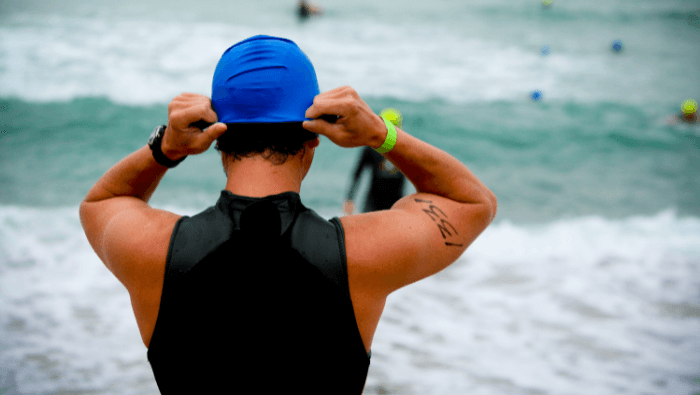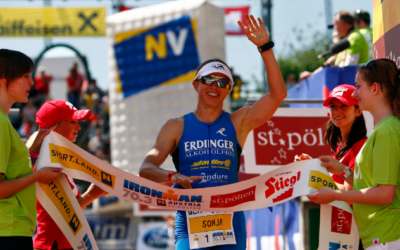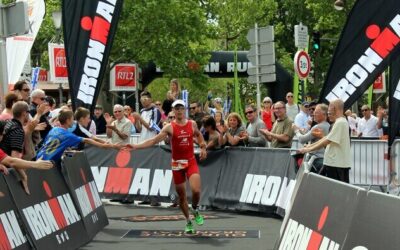Knowing how to warm up for a Triathlon is a crucial step that can significantly impact your performance and overall experience during the race.
A proper warm-up routine prepares your body physically and mentally, helping you achieve peak performance while reducing the risk of injuries.
In this comprehensive guide, we will delve into the importance of warming up for a triathlon and provide you with effective warm-up strategies for various triathlon distances, including sprint, Olympic, half Ironman (70.3), and full Ironman.
Let’s get started!
Why Warming Up is Important
Before diving into the “how-to” of warming up, let’s understand why it is such a critical aspect of preparing for a triathlon:
Enhanced Blood Flow and Oxygen Delivery: Warming up gradually increases your heart rate, dilates blood vessels, and improves blood flow to your muscles. This, in turn, enhances the delivery of oxygen and nutrients to the working muscles, optimizing their performance during the race.
Increased Muscle Temperature: A proper warm-up raises your muscle temperature, making them more flexible and less prone to injury. Warm muscles are better equipped to handle the demands of swimming, cycling, and running.
Mental Preparation: Warming up not only prepares your body but also primes your mind for the upcoming race. It helps reduce pre-race jitters and anxiety while improving focus and concentration.
Injury Prevention: An adequate warm-up can prevent common triathlon-related injuries by loosening tight muscles, tendons, and ligaments, reducing the risk of strains and sprains.
How to Warm Up for a Triathlon
Now that we understand the significance of warming up, let’s explore some comprehensive warm-up routines for all the different Triathlon distances.

How to Warm Up for a Sprint Triathlon and Olympic Distance Triathlon
A well-executed warm-up can make all the difference in your sprint and Olympic distance races. Tailoring your pre-race routine to suit the specific demands of these events will ensure you’re fully prepared to perform at your peak.
Let’s explore an effective warm-up sequence designed to boost your race-day performance.
For sprint distance races, a thorough warm-up is essential. Assuming you’re already in good shape, we recommend starting with a 15-20 minute easy ride on your bike.
Gradually build up your effort during four sets of 1-minute intervals, approaching your threshold. This gradual ramp-up will activate your muscles and get your heart rate up to race levels.
After the cycling warm-up, transition smoothly into a 10-minute easy run. This segment helps maintain the momentum and allows your legs to adapt to the running motion after cycling. It’s a crucial phase to find your stride and focus on the upcoming challenges.
If possible, follow the run with a 5-10 minute swim session. During the swim, incorporate a couple of brief builds, pushing hard for around 20 strokes, to get your body accustomed to swimming at a faster pace. This swim component primes you for the water conditions and the demands of the race.
To keep your body agile and reduce the risk of injury, include dynamic stretching and engaging drills in your warm-up routine. Focus on exercises that enhance flexibility, balance, and coordination, which are crucial elements for performing your best during the race.
When preparing for Olympic distance races, the warm-up has some similarities but slight differences. Start with a 15-minute easy cycling effort to elevate your heart rate and increase blood flow. The aim is to activate your muscles without exhausting yourself before the race even begins.
After the cycling warm-up, transition into a 10-minute run. This running segment serves multiple purposes, not only keeping your muscles activated but also simulating the transition from cycling to running, which is vital for Olympic distance races.
If time permits, spend 5-10 minutes swimming. Like in the sprint distance warm-up, include a few builds during the swim to elevate your heart rate. This swim phase will familiarize you with the water conditions and set the right foundation for your race.
Wrap up both warm-up routines with dynamic stretching and drills to enhance your overall performance. These exercises will further improve muscle flexibility, balance, and coordination, giving you an extra advantage during the race.
How to Warm Up for a Half Ironman Triathlon 70.3
Getting ready for a Half Ironman race requires a well-thought-out warm-up routine that balances the need to raise your core temperature while conserving glycogen for the long endurance event.
Let’s explore some effective warm-up strategies to get you primed for the challenge ahead.
Since it’s a long day of intense physical activity, you don’t want to burn through your glycogen reserves with a lengthy warm-up. Instead, opt for a lighter warm-up that still gets your body ready for action.
A short 5-minute jog is a great way to raise your body temperature and activate your muscles without depleting your energy stores.
If possible, take advantage of any available water access before the race. A brief 5-minute swim with some builds can serve as both a physical warm-up and a mental preparation for the upcoming swim leg.
The repetitive motion of swimming can help calm nerves and improve focus.
Don’t overlook the importance of arm swings in your warm-up routine. They can significantly benefit your shoulder and upper body mobility, which are crucial for the swim, bike, and run portions of the race.
A few minutes of arm swings can help reduce the risk of injury and enhance your performance.
During the race, it’s generally advisable to pace yourself and build into it gradually. Starting at a comfortable and sustainable pace allows your body to adapt to the increasing demands of the race.
As you progress, you can gradually increase your effort and speed, ensuring you have enough endurance for the entire event.
How to Warm Up for a Full Ironman Triathlon
When it comes to getting ready for a full Ironman Triathlon, I usually tell triathletes to skip the hardcore warm-up stuff.
The day’s gonna be super long, and going all out with running or cycling beforehand might not do much good.
If you can, it’s cool to get in the water and loosen up your upper body a bit, but don’t stress if you can’t manage it.
Once the race kicks off, remember to stay disciplined and ease into it. Don’t go crazy with full speed from the get-go. Start at a modest effort and then crank it up gradually as you go.
By being smart about your energy and taking it easy at first, you’ll have the stamina to take on all the crazy challenges that’ll come your way.
Keep in mind, an Ironman is not just about physical strength, it’s also a mental game. So when you dive in and take on this epic adventure, trust your training, stay focused, and let your determination carry you across that finish line like a boss.
The road might be tough, but with your cool approach and unbeatable spirit, you’ll crush it and complete the legendary Ironman!
Other Warm-Up Considerations

Preparing for a race at the crack of dawn brings its own set of unique challenges. The dim light and time constraints make it difficult to squeeze in a proper bike warm-up before the event.
However, with a few smart adjustments, you can still ensure you’re primed and ready for the competition.
Given the safety concerns of cycling in the dark, traditional outdoor warm-ups might not be feasible. But fear not, for there’s an alternative – the stationary trainer.
By utilizing this indoor tool, you can get your blood flowing and muscles engaged, all within the safe confines of your home.
Moreover, don’t let the absence of a bike warm-up stress you out, as the upcoming run can help you warm up your biking legs effectively.
While strategizing your warm-up routine, keep in mind the order of exercises. It’s crucial to prioritize the swim warm-up as the race kicks off with this segment. You want your arms to be in their best form right before you dive in.
Aim to conclude the swim warm-up around 5 to 10 minutes prior to the race start. In some instances, time constraints might force you to wrap it up a bit earlier, and that’s alright; adaptability is key.
In the face of limited time, it’s essential to make the most of the available options. If a complete warm-up isn’t possible, consider a shortened run warm-up or omit it entirely. Instead, opt for dynamic stretches and form drills to awaken your muscles and get your body in race mode.
Amidst the various warm-up priorities, never underestimate the significance of feeling comfortable and at ease in the water.
Especially if you’re contemplating wearing a thermal cap, take advantage of the swim warm-up to test it out.
This valuable trial run can help you make an informed decision and potentially enhance your performance during the race.
How NOT to Warm Up: Common Warm-Up Mistakes to Avoid
While warming up is essential, there are some common mistakes that athletes often make, which can hinder performance or increase the risk of injury:
Skipping the Warm-Up: Some athletes may underestimate the importance of warming up and choose to skip it altogether. Avoid this mistake, as it may lead to suboptimal performance and an increased chance of injury.
Static Stretching: Static stretching (holding a stretch in one position) before a triathlon can decrease muscle power and performance. Save static stretches for after the race.
Overexertion: Pushing yourself too hard during the warm-up can leave you fatigued before the race even begins. While some intensity is beneficial, avoid exhausting yourself.
Ignoring Mental Preparation: Warming up isn’t just about physical readiness; it’s also an opportunity to mentally prepare for the race. Avoid neglecting the mental aspect of your warm-up.
Common Myths About Warm-Ups
There are several myths surrounding warm-ups that need debunking to ensure athletes understand the best practices:
Myth: Long Warm-Ups are Always Better: It really depends on the type of Triathlon you will be participating in. Always keep warm-ups appropriate to the race distance.
Myth: Static Stretching is Essential: As mentioned earlier, static stretching before a triathlon can decrease muscle power. Focus on dynamic stretching instead.
Myth: Warm-Ups are Only for Beginners: Athletes of all levels, from beginners to elite, can benefit from a proper warm-up routine. Never underestimate its importance, regardless of your skill level.
Myth: Warming Up Wastes Energy: On the contrary, a well-structured warm-up conserves energy and optimizes performance during the race.
Conclusion
Warming up for a triathlon is not a step to be overlooked or underestimated. A comprehensive warm-up routine not only prepares your body for the physical demands of swimming, cycling, and running but also sets the stage for a successful race mentally.
From sprint triathlons to full Ironman races, understanding how to warm up properly and avoid common mistakes is essential to reaching your full potential as a triathlete.
Remember to individualize your warm-up, practice transitions, and stay hydrated throughout the process.
By implementing the strategies and tips outlined in this guide, you’ll be better equipped to achieve your triathlon goals and enhance your overall race experience.
So, make warming up an integral part of your triathlon journey and witness the positive impact it has on your performance. Happy racing!





0 Comments